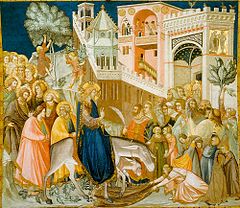Palm Sunday
| Palm Sunday | |
|---|---|

Entry of Christ into Jerusalem (1320) by Pietro Lorenzetti: entering the city on a donkey symbolizes arrival in peace rather than as a war-waging king arriving on a horse
|
|
| Significance | commemorates Jesus' triumphal entry into Jerusalem |
| Date | Moveable feast, Sunday before Easter |
Palm Sunday is a Christian moveable feast that falls on the Sunday before Easter. The feast commemorates Jesus' triumphal entry into Jerusalem, an event mentioned in each of the four canonical Gospels.
In many Christian denominations, worship services on Palm Sunday include a procession of the faithful carrying palms, representing the palm branches the crowd scattered in front of Jesus as he rode into Jerusalem. The difficulty of procuring palms in unfavorable climates led to their substitution with branches of native trees, including box, olive, willow, and yew. The Sunday was often named after these substitute trees, as in Yew Sunday, or by the general term Branch Sunday.
In the accounts of the four canonical Gospels, Jesus' triumphal entry into Jerusalem takes place about a week before his Resurrection.
Christian theologians believe that the symbolism is captured prophetically in the Old Testament: "The Coming of Zion's King – See, your king comes to you, righteous and victorious, lowly and riding on a donkey, on a colt, the foal of a donkey". It suggests that Jesus was declaring he was the King of Israel to the anger of the Sanhedrin.
According to the Gospels, Jesus Christ rode a donkey into Jerusalem, and the celebrating people there laid down their cloaks and small branches of trees in front of him, and sang part of – ... Blessed is He who comes in the name of the Lord. We bless you from the house of the Lord ....
The symbolism of the donkey may refer to the Eastern tradition that it is an animal of peace, versus the horse, which is the animal of war. A king would have ridden a horse when he was bent on war and ridden a donkey to symbolize his arrival in peace. Jesus' entry to Jerusalem would have thus symbolized his entry as the Prince of Peace, not as a war-waging king.
...
Wikipedia
